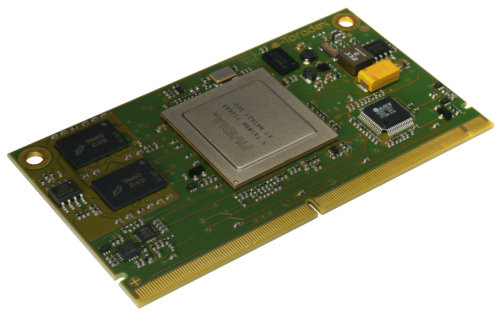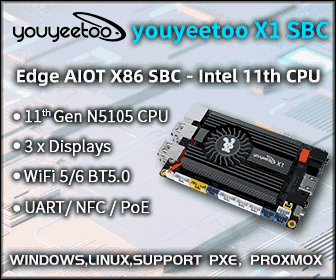Last month, Toradex released the preliminary specification for Apalis, a Computer on Module (CoM) architecture. Although the Apalis specification has been initially designed with ARM based processors in mind such as the Nvidia Tegra, Freescale i.MX and Texas Instruments OMAP processor families, it aims at being device and chip architecture independent. The Apallis specification defines the following: Interface Specifications: Signal Naming Convention – Rules to name pins (e.g. VCC, PWM1, PWM2, ) which are used for all modules. Signal Definition – Details about the pins named above Physical Pin Definition and Location Mechanical Specifications: Mounting and Fixation Module Size – Standard: 82 x 45mm | Extended: 82 x 56mm Pin Numbering – There is a total of 321 pin numbers (but a few less actually pins) Electrical Specifications: Power Supplies Power Control Back Feed Protection This specifications also defines mounting mechanisms for active cooling (e.g. heat spreaders) in case those […]
Amahi 6.1 for Ubuntu 12.04 Released
Amahi has just announced the release of Amahi 6.1, Ubuntu Edition, an Home Digital Assistant (HDA). Amahi used to only work for Fedora and this is their very first stable release for Ubuntu 12.04. The key features of Amahi 6.1, Ubuntu Edition include: Greyhole 0.9 (storage pooling technology) Reliability fixes and updates New look Support for 32 / 64-bit Desktop and Server versions of Ubuntu Improved cloud storage with Amahi Sync Preliminary support ARM platforms such as PandaBoard and BeagleBoard One-Click App installs via Amahi’s application store If you want to get started with Amahi, you’ll have to register (and get an install code), and follow a few command line instructions. The instructions are the same to install on ARM platforms (assuming you already have Ubuntu 12.04 running), but Amahi developers recommend to install it to an hard drive instead of an SD card for performance reasons. They are also […]
Android Transporter Enables WiFi Display Mirroring (similar to Miracast) of Android Devices
E.S.R.Labs is a German embedded software company mainly working for the automotive industry. But this time, they’ve started to work for the consumer market with Android Transformer, a software solution that can mirror an Android display to another Android device display via Wi-Fi in a similar fashion to what WiFi Miracast will do. Eventually, the company plan to make Android Transporter compatible with Wi-Fi Miracast, but in the meantime they rolled out their own solution by taking advantage of H.264 hardware encoders and decoders on Galaxy Nexus S and the Raspberry Pi. If they use standard APIs, I assume any hardware running Android that with H.264 hardware encode/decode should support their platform. I hope it will be work on (or be ported to) CX-01 mini PC which can be bought as low as $40 inc. shipping. It would make an even cheaper hardware than the Raspberry Pi (Up to 33% […]
Mozilla Renames Boot 2 Gecko to Firefox OS and Partners with ZTE & TCL
Mozilla announced it would rename its Boot 2 Gecko (B2G) HTML5 mobile operating system to Firefox OS, and that ZTE and TCL (under the Alcatel brand) would manufacture the first devices running Firefox OS using Qualcomm Snapdragon Processors. The first devices should be available early 2013, at first in Brazil through Vivo, Telefónica’s commercial brand. The company also said that telecom operators such as Deutsche Telekom, Etisalat, Smart, Sprint, Telecom Italia, Telefónica and Telenor are planning to sell Firefox OS based smartphones. The platform is said to be optimized for entry-level smartphones thanks to the removal of unnecessary middleware layers among other things. This should allow mobile operators to provide low-cost handsets with “richer experiences” for the developing markets. Firefox OS will be fully open source and the reference implementation of the required Web APIs is being submitted to W3C for standardization. Internally, the project still appears to be referred to […]
Use GNU Parallel to Speed Up Script Execution on Multiple Cores and/or Machines
I attended BarCamp Chiang Mai 5 last week-end, and a lot of sessions were related to project management, business apps and web development, but there were also a few embedded systems related sessions dealing with subjects such as Arduino (Showing how to blink an LED…) and IOIO board for Android, as well as some Linux related sessions. The most useful talk I attended was about “GNU Parallel”, a command line tool that can dramatically speed up time-consuming tasks that can be executed in parallel, by spreading tasks across multiple cores and/or local machines on a LAN. This session was presented by the developer himself (Ole Tange). This tool is used for intensive data processing tasks such as DNA sequencing analysis (Bioinformatics), but it might be possible to find a way to use GNU Parallel to shorten the time it takes to build binaries. Make is already doing a good job at […]
webOS Community Edition Release for HP TouchPad
Open webOS 1.0 is planned to be released in September 2012, but in the meantime, the development team has released an intermediate webOS “Community Edition” for the HP TouchPad. This code is different from the Open webOS project, and is composed of additional components from the current release of webOS for the TouchPad. The open webOS project team has been working with WebOS Internals to bring this release out for legacy TouchPad devices. Thanks to the release of the webOS Community Edition, it is now possible to learn how the TouchPad works, modify your TouchPad experience and then apply that to Open webOS 1.0 once it is released. The Community Edition only supports HP TouchPad, whereas Open webOS 1.0 release will enable the community to port webOS to different hardware platform, and add more features by using open source stacks such as BlueZ bluetooth and GStreamer. You’ll need to download […]
Linaro 12.06 Release with Kernel 3.5 and Android 4.0.4
Linaro has released version 12.06 based on Linux Kernel 3.5-rc3 and Android 4.0.4 (r2.1). This release brings further multimedia enablement for Android as well as some improvement to perf for Android, improved instructions & scripts for multi-arch on Ubuntu, and lots of little improvements and bugs fixes. Here are the highlights of the release: Android Multimedia enablement on AOSP, patches are in review. Most of the benchmarking applications have been automated via Monkeyrunner, working on PandaBoard and Snowball. Update panda-ics-gcc47-tilt-tracking-blob build to the TI LT 3.4 kernel. USB camera preview and still capture forward ported to tilt-tracking. 3D graphics and multimedia working on tilt-stable. IOMMU for Origen’s Multi format codec (MFC) enabled. IOMMU for Origen’s FIMC enabled. (FIMC stands for Fully Interactive Mobile Camera, and it’s used for camera input). Snowball upgraded to Android 4.0.4. Cortex strings landed in Linaro Android and submitted to AOSP (https://android-review.googlesource.com/#/c/38031/). This is part of […]
Mediatek Unveils MT6577 Dual Core Cortex A9 Application Processor
MediaTek has announced the availability of the MT6577, a dual-core Cortex A9 application processor with a PowerVR Series5 SGX GPU that targets sub-$200 smartphones. The successor of MT6575 single core Cortex A9 mobile processor also includes MediaTek’s 3G/HSPA modem. The processor supports Android 4.0, and the company claims browser performance improvement by up to 40% compared to single-core platforms. The MT6577 also supports 8MP camera sensors, can handle 1080p video playback and has the ability to support HD720 (1280×720) resolution displays. The platform also embeds MediaTek 4-in-1 connectivity combo that provides 802.11n Wi-Fi & BT4.0 connectivity, GPS and FM. The MT6577 is pin-to-pin compatible with MT6575, so handset manufacturers can just use existing designs to upgrade to dual core, or design a single PCB with both single and dual core handsets. The first smartphones featuring MT6577 should be available in Q3 2012. That’s all information I have for now.











